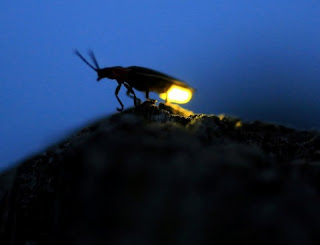When I was a kid, summer was my favorite season. No
school, great weather, fresh blueberries and strawberries, the smell of freshly
cut grass, and endless days of running around in the woods with my friends.
Evenings were magical because I could go outside and catch the fireflies. It
was easy while there was still some daylight (unless they went higher than my
little arms could reach) but as it got darker they became harder to find in
between blinks. Looking back, I wonder why I did it. I didn’t do anything with
them besides let them walk around on my hand before flying away. The magic
returned when I got to watch my daughter chase them around the yard, while my
wife watched in bewilderment. Poor thing grew up without fireflies, and alien
species in the Northwest.
Traditionally, fireflies (the are actually a beetle,
not a fly) first appear right around Memorial Day and vanish just before Labor
Day, but I remember one year we had a weird spring and they were a month late.
However, they stayed through September to make up for missing most of June. The
flashes they give off are the fascinating phenomenon of bioluminescence a living
light source. They are trying to find a mate to make the next generation
fireflies and keep summer nights full of wonder and amazement.
 |
| Firefly dorsal view (Missouri Department of Conservation) |
Last year I got a disturbing report from my mom back
in the Old Country (Pennsylvania) that she isn’t seeing as many fireflies in
recent years. I contacted Christopher Tipping, an entomologist at Delaware
Valley University in nearby Doylestown to see if he has been noticing any
trends. He told me the same thing I hear about so many other species: habitat
loss. He says weather can also be a factor, as I discovered the year they were
a month late.
 |
| Firefly in flight, between blinks (Smithsonian Magazine) |
Every living thing on the planet requires food, water,
air, and a space to call home. Insects are no different. Recall from an earlier
Nature Minute I discussed the disappearance of bees, and habitat loss was on
the list of suspects. What kind of habitat do fireflies prefer?
While there are many different firefly species (maybe
even several in your yard at once) they generally seem to prefer an open area
like a meadow or your back yard where they can see each other’s flashes, or
forest edges. Larva live in the ground and require moist soil, which in my
experience is common in woodlands. There is still much to be learned about how
moist they need their soil or how artificial light sources affect their
matchmaking skills.
Enjoy a National Geographic video on fireflies.
 |
| Firefly in full blink (Washington Post) |
Are you interested in protecting or enhancing your
firefly habitat? As a National Wildlife Foundation Habitat Steward, I can help.
Together we can keep summer nights magical for kids everywhere. This week's information comes from Christopher Tipping, National Wildlife Foundation, and Firefly Watch.
MO Dept of Conservation: https://nature.mdc.mo.gov/discover-nature/field-guide/fireflies-lightning-bugs
Smithsonian Magazine: http://www.smithsonianmag.com/science-nature/14-fun-facts-about-fireflies-142999290/
Washington Post: https://www.washingtonpost.com/news/to-your-health/wp/2015/07/22/scientists-are-working-with-the-light-of-fireflies-to-improve-medical-diagnoses/?utm_term=.b7d5ed9a0da6
No comments:
Post a Comment